Fracture Analysis of Short-Scale Corroded/Healthy Reinforced Concrete Beams under Bending Using Acoustic Emission
Abstract
:1. Introduction
2. Literature Review
3. Materials and Methods
3.1. Specimens Confection
3.2. Corrosion Assessment Using Impressed Current Technique
3.3. Bending Test Using AE Technique
3.3.1. AE Technique Approach
3.3.2. Bending Test Process
3.3.3. AE Analysis Method
- Fracture scale classification: Fractures were classified in terms of the intervals related to the maximum amplitudes of AEs generated inside the specimens during the bending test. The mean (µ) and standard deviation (σ) of the maximum amplitudes were used. Therefore, three intervals, Iminor, Imedium, and Imajor, were established, respectively, related to minor fracture, medium fracture, and major fracture. They are presented in Equations (1)–(3), and the results are shown in Table 3.
- RA values and average frequencies parameters: Based on these three fracture scale intervals, a classification of the RA values and the average frequencies was performed as well to classify the cracks mode in shear-type and tensile-type. The RA values and the average frequencies were obtained from the AE parameters [32,33] using Equations (4) and (5) as follows:where Rise Time is the time from an AE signal’s first threshold crossing to its peak; Maximum amplitude is the largest voltage peak value in an AE signal waveform; Count is the number of times an AE signal crosses the detection threshold; and Duration is the time that elapses from the crossing of the first threshold to the end of the last threshold crossing of an AE signal from the AE threshold.
- Failure stages classification and AE sources’ location: The moving average of the maximum AE amplitudes, generated during bending testing, was explored to identify the different failure stages with time history. Therefore, a range of 50 was used to set the moving average of the maximum amplitude of AE events. Furthermore, to evaluate the concentration of AE sources generated during the bending process, a three-dimensional representation was adopted. Therefore, square cells with the dimensions of 10 mm × 10 mm were designed on the specimens’ sides surface via the x, y, and z axis. In each case, the maximum value of the concentration of AE sources in a cell via the front side of the specimen were determined, where i and j are, respectively, the position of a cell in the x axis from 1 to 40, and in the z axis from 1 to 10 (Figure 5). Then, the minimum of those four maxima , presented in Table 4, were considered to define four categories of AE sources concentration in a three-dimensional representation (Equations (6)–(9)).where n is the concentration of AE sources in a cell in a three-dimensional representation.
4. Results and Discussions
4.1. Compressive and Tensile Bending Stresses and Rebar Strain
4.2. AE Hits and Load
4.3. Failure Stages Classification with Maximum AE Amplitude
4.4. RA Values and Average Frequencies Parameters
4.5. AE Sources and Crack Patterns
5. Conclusions
- During the bending tests up to failure, the fluctuation of the moving average of the AE maximum amplitudes distinguished four stages of fracture behavior in the healthy condition, in the 0.9% corrosion level, and in the 3.2% corrosion level. These stages were, respectively, related to the nucleation of cracks, the formation of macrocracks from the bottom area of the specimens toward the upper areas, the opening of macrocracks, and the occurrence of failure.
- However, in the case of a severe corrosion level of 9.3%, the fluctuation of the moving average of the AE maximum amplitudes distinguished only three fracture stages because the formation and the opening of macrocracks occurred simultaneously due to the severity of corrosion.
- The mean and the standard deviation of the AE maximum amplitudes allowed the classification of the fractures into minor fractures, medium fractures, and major fractures.
- Based on the three fracture scales, the RA values, and the average frequencies provided a classification of both damage scales and cracks mode (in tensile type and shear-type). Although there is not yet a standard method for fixing the boundary line in the classification of RA values and average frequencies to identify tensile-type and shear-type damages, the method used in this work made possible a comparative analysis of the fracture modes between the healthy condition and the corroded cases.
- Using the digital analysis method proposed in this study, the progress of rebar corrosion could be revealed by the decreasing trend of the concentration of AE sources.
Author Contributions
Funding
Data Availability Statement
Conflicts of Interest
References
- Verstrynge, E.; Steen, C.V.; Vandecruys, E.; Wevers, M. Steel corrosion damage monitoring in reinforced concrete structures with the acoustic emission technique: A review. Constr. Build. Mater. 2022, 349, 128732. [Google Scholar] [CrossRef]
- Ohtsu, M.; Tomoda, Y. Acoustic Emission Techniques for Rebar Corrosion in Reinforced Concrete. In Advances in Construction Materials; Springer: Berlin/Heidelberg, Germany, 2007. [Google Scholar] [CrossRef]
- Kawasaki, Y.; Tomoda, Y.; Ohtsu, M. AE Monitoring of Corrosion Process in Cyclic Wet-Dry Test. Constr. Build. Mater. 2010, 24, 2353–2357. [Google Scholar] [CrossRef]
- Ohtsu, M.; Tomoda, Y. Corrosion Process in Reinforced Concrete Identified by Acoustic Emission. Mater. Trans. 2007, 48, 1184–1189. [Google Scholar] [CrossRef]
- Ohtsu, M.; Tomoda, Y. Phenomenological Model of Corrosion Process in Reinforced Concrete Identified by Acoustic Emission. ACI Mater. J. 2008, 105, 194. [Google Scholar] [CrossRef]
- Zaki, A.; Chai, H.K.; Behnia, A.; Aggelis, D.G.; Tan, J.Y.; Ibrahim, Z. Monitoring Fracture of Steel Corroded Reinforced Concrete Members Under Flexure by Acoustic Emission Technique. Constr. Build. Mater. 2017, 136, 609–618. [Google Scholar] [CrossRef]
- Zaki, A.; Tan, J.Y.; Chai, H.K.; Aggelis, D.G. Assessment of Corrosion Damage using Acoustic Emission Technique under Load Testing. In Proceedings of the 7th Asia Pacific Young Researchers and Graduates Symposium, Kuala Lumpur, Malaysia, 20–21 August 2015; Available online: https://www.researchgate.net/publication/281287739 (accessed on 25 March 2018).
- Leelalerkiet, V.; Shimizu, T.; Tomoda, Y.; Ohtsu, M. Estimation of Corrosion in Reinforced Concrete by Electrochemical Techniques and Acoustic Emission. J. Adv. Concr. Technol. 2005, 3, 137–147. [Google Scholar] [CrossRef]
- Behnia, A.; Chai, H.K.; Yorikawa, M.; Momoki, S.; Terazawa, M.; Shiotani, T. Integrated Non-Destructive Assessment of Concrete Structures Under Flexure by Acoustic Emission and Travel Time Tomography. Constr. Build. Mater. 2014, 67 Pt B, 202–215. [Google Scholar] [CrossRef]
- Aggelis, D.G.; Soulioti, D.V.; Sapouridis, N.; Barkoula, N.M.; Paipetis, A.S.; Matikas, T.E. Acoustic Emission Characterization of the Fracture Process in Fibre Reinforced Concrete. Constr. Build. Mater. 2011, 25, 4126–4131. [Google Scholar] [CrossRef]
- He, R.; Ma, H.; Hafiz, R.B.; Fu, C.; Jin, X.; He, J. Determining porosity and pore network connectivity of cement-based materials by a modified non-contact electrical resistivity measurement: Experiment and theory. Mater. Des. 2018, 156, 82–92. [Google Scholar] [CrossRef]
- He, R.; Nantung, T.; Olek, J.; Lu, N. Field study of the dielectric constant of concrete: A parameter less sensitive to environmental variations than electrical resistivity. J. Build. Eng. 2023, 74, 106938. [Google Scholar] [CrossRef]
- Zhou, K.; Lei, D.; He, J.; Zhang, P.; Bai, P.; Zhu, F. Real-time localization of micro-damage in concrete beams using DIC technology and wavelet packet analysis. Cem. Concr. Compos. 2021, 123, 104198. [Google Scholar] [CrossRef]
- Jing, H.; Yin, Q.; Yang, S.; Chen, W. Micro-Mesoscopic Creep Damage Evolution and Failure Mechanism of Sandy Mudstone. Int. J. Geomech. 2021, 21, 04021010. [Google Scholar] [CrossRef]
- Xu, X.; Zhou, Y.; Chen, W.; Gao, Y.; Fu, Q.; Liu, X.; Feng, C. Macro-Microscopic Deterioration Behavior of Gypsum Rock after Wetting and Its Constitutive Model Based on Acoustic Emission. Minerals 2022, 12, 1168. [Google Scholar] [CrossRef]
- Chen, Z.; Zhang, G.; He, R.; Tian, Z.; Fu, C.; Jin, X. Acoustic emission analysis of crack type identification of corroded concrete columns under eccentric loading: A comparative analysis of RA-AF method and Gaussian mixture model. Case Stud. Constr. Mater. 2023, 18, e02021. [Google Scholar] [CrossRef]
- Seye, M.M.; Kawasaki, Y. Failure mechanisms of corroded/non-corroded RC cylinder under axial compressive loading evaluated by AE technique. Front. Built Environ. 2022, 8, 947310. [Google Scholar] [CrossRef]
- Zheng, Y.; Wen, Y.; Pan, T.; Liu, Y.; Zhou, Y.; Li, Y.; Zhou, Y. Fractal characteristics and damage evaluation of corroded beams under four-point bending tests based on acoustic emission techniques. Measurement 2022, 202, 111792. [Google Scholar] [CrossRef]
- Kawasaki, Y.; Wasada, S.; Okamoto, T.; Izuno, K. Evaluation for RC specimen damaged from rebar corrosion by acoustic emission technique. Constr. Build Mater. 2014, 67, 157–164. [Google Scholar] [CrossRef]
- Prem, P.R.; Murthy, A.R. Acoustic emission monitoring of reinforced concrete beams subjected to four-point-bending. Appl. Acoust. 2017, 117, 28–38. [Google Scholar] [CrossRef]
- Zaki, A.; Ibrahim, Z.; Ying, T.J. Acoustic Emission Signal Analysis on Corroded Concrete Beam. IOP Conf. Ser. Mater. Sci. Eng. 2021, 1144, 012041. [Google Scholar] [CrossRef]
- Abouhussien, A.A.; Hassan, A.A.A. Acoustic emission-based analysis of bond behavior of corroded reinforcement in existing concrete structures. Struct. Control Health Monit. 2017, 24, e1893. [Google Scholar] [CrossRef]
- Garhwal, S.; Sharma, S.; Sharma, S.K. Acoustic emission monitoring of RC beams corroded to different levels under flexural loading. Arab J. Sci. Eng. 2020, 46, 4319–4335. [Google Scholar] [CrossRef]
- Carpinteri, A.; Lacidogna, G.; Niccolini, G. Damage analysis of Reinforced Concrete Buildings by the Acoustic Emission Technique. Struct. Control Health Monit. 2011, 18, 660–673. [Google Scholar] [CrossRef]
- Calabrese, L.; Campanella, G.; Proverbio, E. Identification of Corrosion Mechanisms by Univariate and multivariate Statistical Analysis during Long Term Acoustic Emission Monitoring on a pre-Stressed Concrete Beam. Corros. Sci. 2013, 73, 161–171. [Google Scholar] [CrossRef]
- Steen, C.V.; Verstrynge, E.; Wevers, M.; Vandewalle, L. Assessing the Bond Behaviour of Corroded Smooth and Ribbed Rebars with Acoustic Emission Monitoring. Cem. Concr. Res. 2019, 120, 176–186. [Google Scholar] [CrossRef]
- Colombo, S.; Main, I.G.; Forde, M.C. Assessing Damage of Reinforced Concrete Beam Using ‘b-value’ Analysis of Acoustic Emission Signals. J. Mater. Civ. Eng. 2003, 15, 280–286. [Google Scholar] [CrossRef]
- Grosse, C.U.; Reinhardt, H.W.; Finck, F. Signal-Based Acoustic Emission Techniques in Civil Engineering. J. Mater. Civ. Eng. 2003, 15, 274–279. [Google Scholar] [CrossRef]
- Ohno, K.; Ohtsu, M. Crack Classification in Concrete Based on Acoustic Emission. Constr. Build. Mater. 2010, 24, 2339–2346. [Google Scholar] [CrossRef]
- Steen, C.V.; Pahlavan, L.; Wevers, M.; Verstrynge, E. Localisation and characterisation of corrosion damage in reinforced concrete by means of acoustic emission and X-ray computed tomography. Constr. Build. Mater. 2019, 197, 21–29. [Google Scholar] [CrossRef]
- Nguyen-Tat, T.; Ranaivomanana, N.; Balayssac, J.P. Characterization of Damage in Concrete Beams under Bending with Acoustic Emission Technique (AET). Constr. Build. Mater. 2018, 187, 487–500. [Google Scholar] [CrossRef]
- Aggelis, D.G. Classification of cracking mode in concrete by acoustic emission parameters. Mech. Res. Commun. 2011, 38, 153–157. [Google Scholar] [CrossRef]
- Nondestructive Testing—Acoustic Emission Inspection—Test Method for Classification of Active Cracks in Concrete Structures; ISO: Geneva, Switzerland, 2019. Available online: https://standards.iteh.ai/catalog/standards/sist/8d5f7c66-0f7e-4f3a-8801-fffcfc6dd38f/iso-16838-2019 (accessed on 24 January 2019).
- Kearsley, E.P.; Joyce, A. Effect of corrosion products on bond strength and flexural behaviour of reinforced concrete slabs. J. S. Afr. Inst. Civ. Eng. 2014, 56, 21–29. Available online: https://hdl.handle.net/10520/EJC158380 (accessed on 3 September 2019).
- Coccia, S.; Imperatore, S.; Rinaldi, Z. Influence of corrosion on the bond strength of steel rebars in concrete. Mater. Struct. 2016, 49, 537–551. [Google Scholar] [CrossRef]
- Aryanto, A.; Shinohara, Y. Bond Behavior between Steel and Concrete in Low Level Corrosion of Reinforcing Steel. In Proceedings of the 15th World Conference on Earthquake Engineering (15WCEE), Lisbon, Portugal, 24–28 September 2012; Available online: https://www.iitk.ac.in/nicee/wcee/article/WCEE2012_0369.pdf (accessed on 3 September 2019).




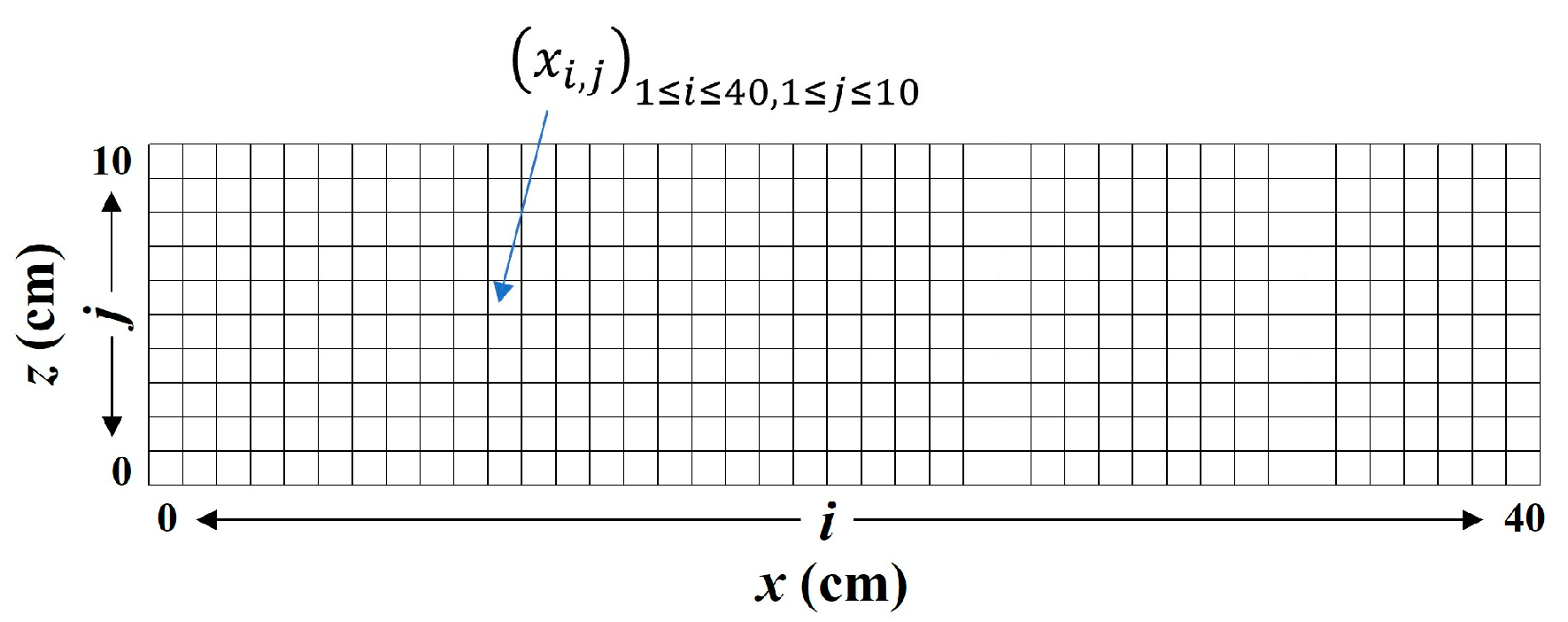
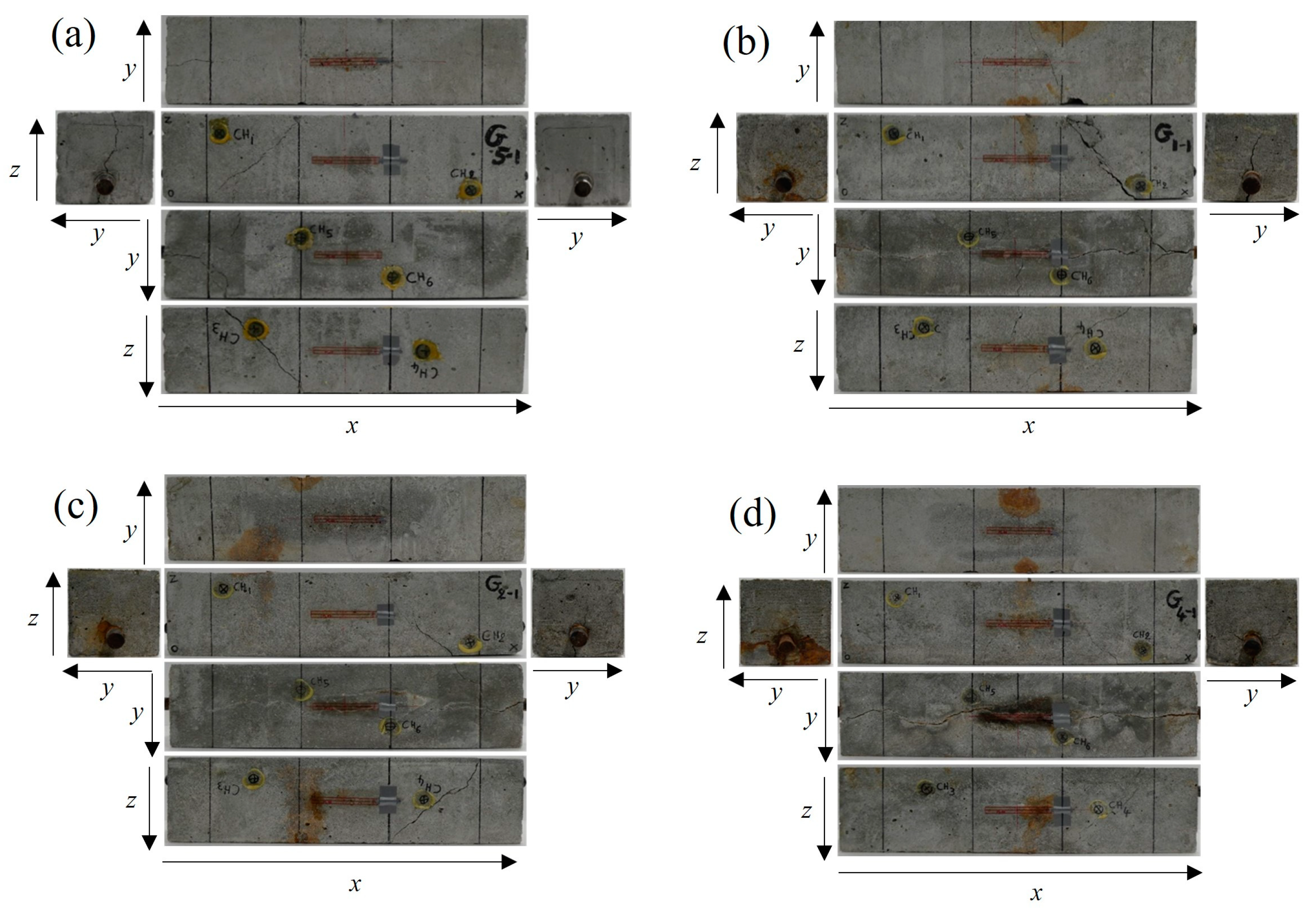


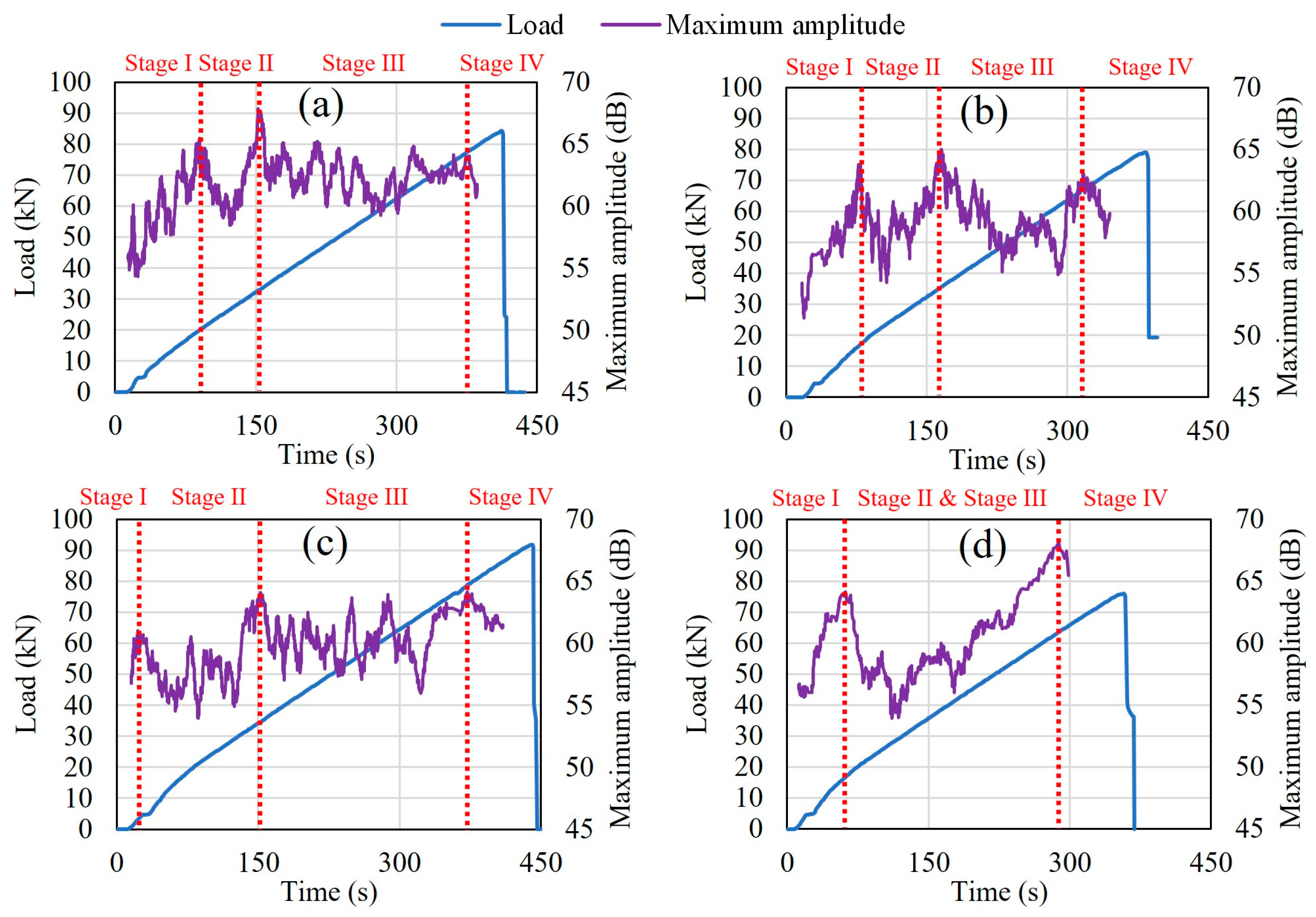
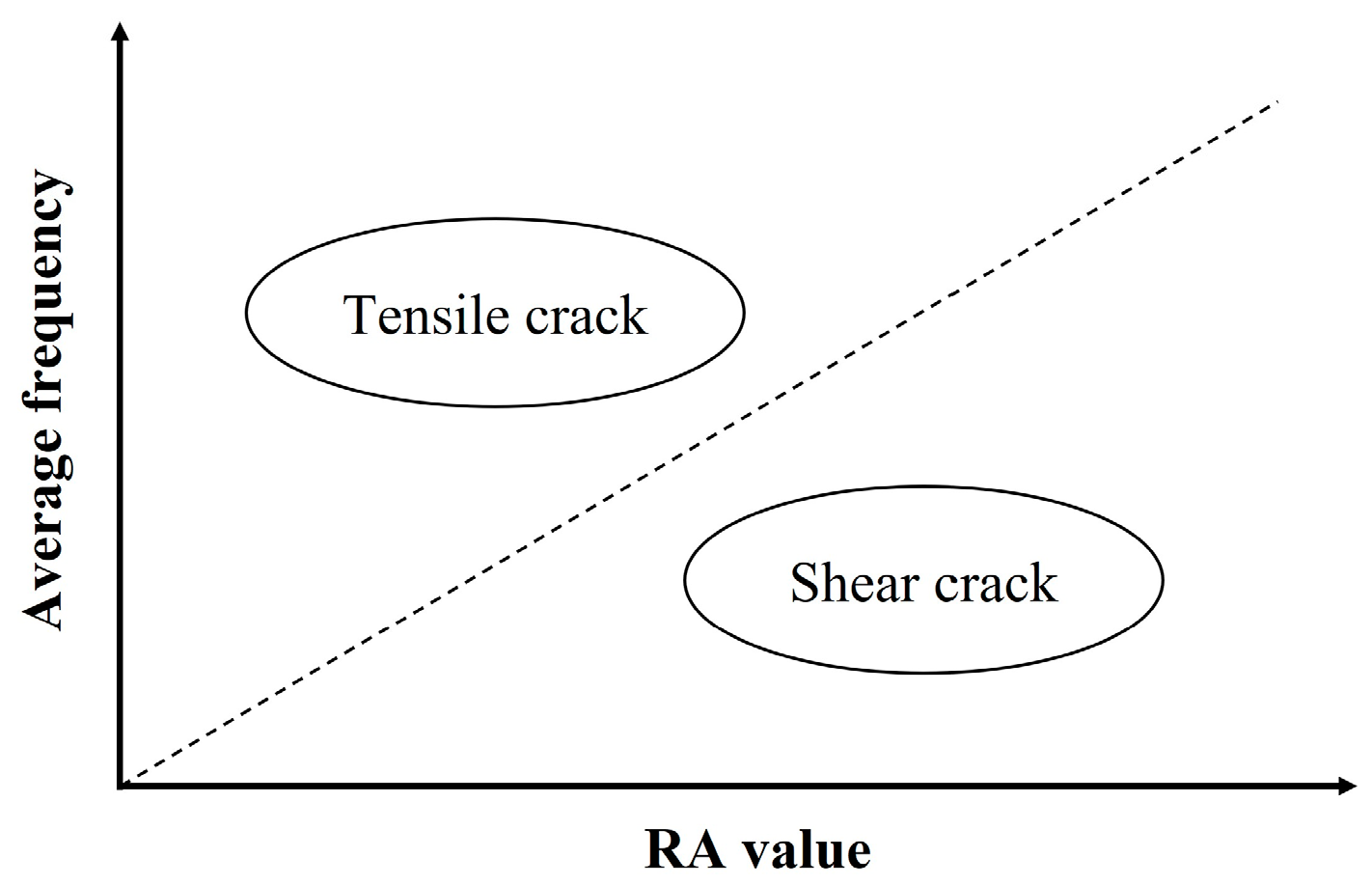
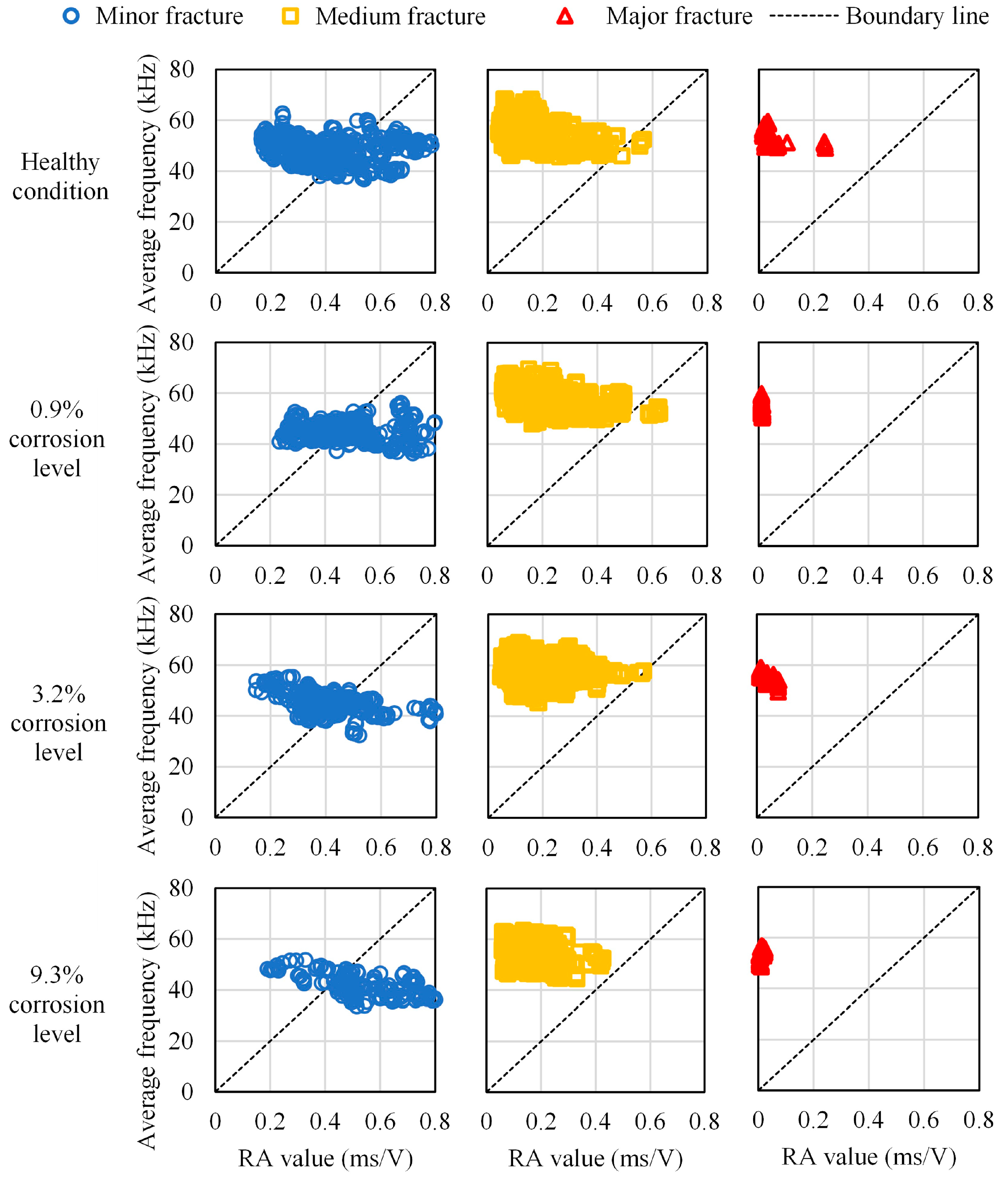
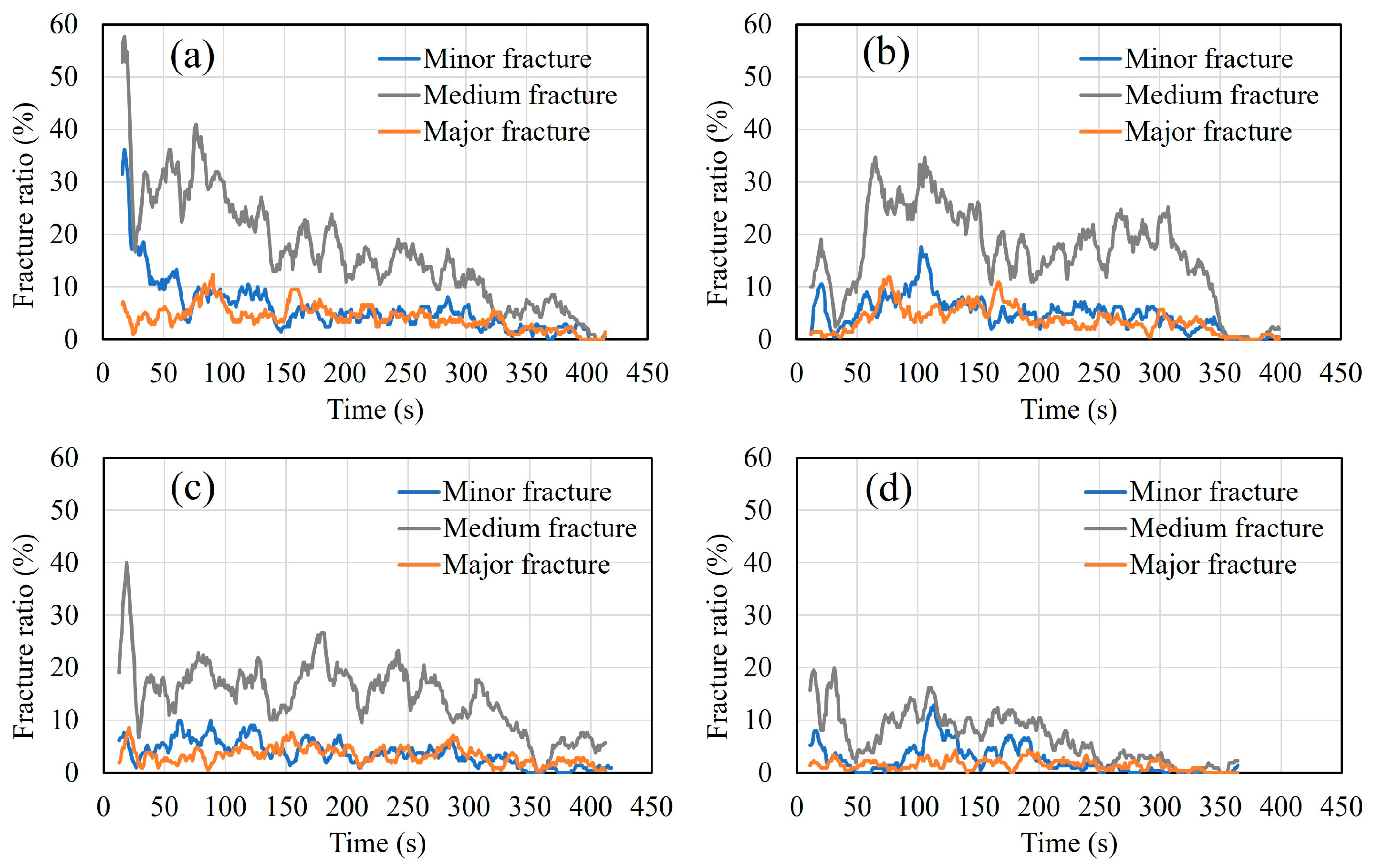

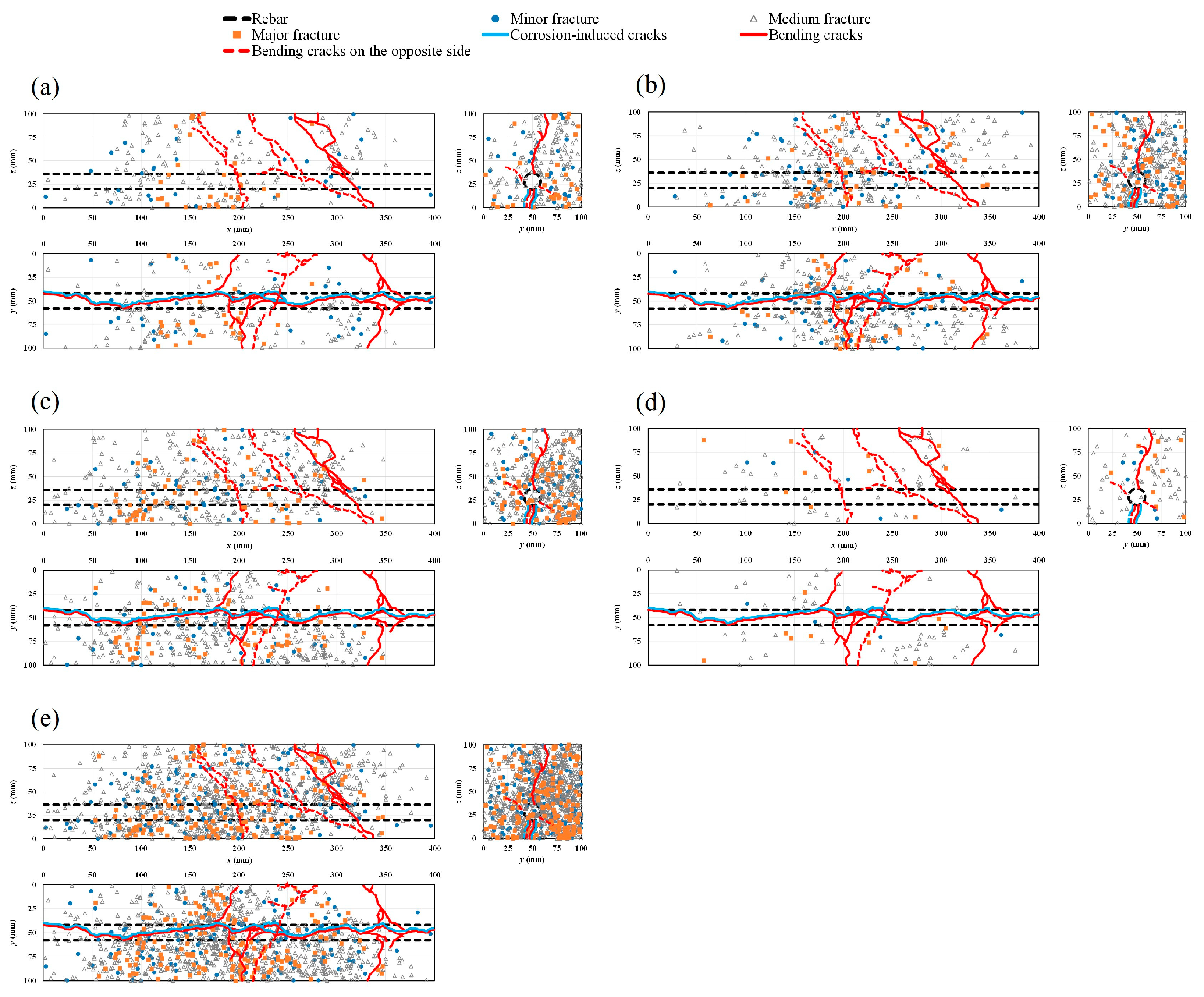

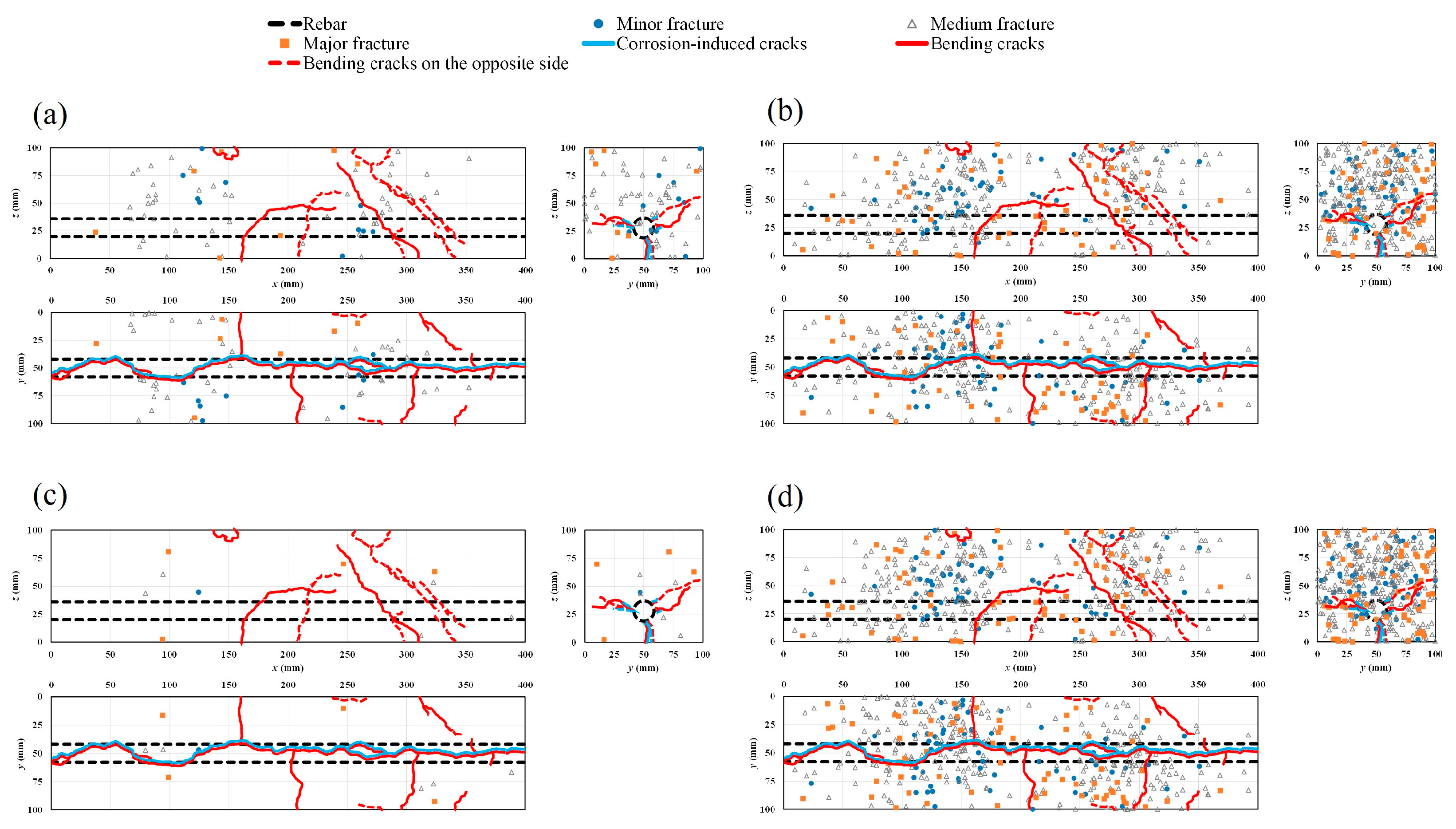

| Water- Cement Ratio (%) | Sand- Aggregate Ratio (%) | kg/m3 | ||||||
|---|---|---|---|---|---|---|---|---|
| Cement: Ordinary Portland Cement | Sand | Gravel | Water | Water Reducing Agent (C × 0.8%) | Air Entrainment (Diluted 100 Times, C × 0.4%) | |||
| Fine Aggregate (05 mm–15 mm) | Coarse Aggregate (10 mm–20 mm) | |||||||
| 50 | 46.5 | 332 | 808 | 489 | 489 | 166 | 2.66 | 0.66 |
| Targeted slump: 12 ± 2.5 cm; Targeted air content: 4.5 ± 1.5% | ||||||||
| Sensor Channel | Coordinates (mm) | Side | ||
|---|---|---|---|---|
| x | y | z | ||
| Ch. 1 | 65 | 0 | 80 | Front |
| Ch. 2 | 340 | 0 | 15 | Front |
| Ch. 3 | 100 | 100 | 25 | Back |
| Ch. 4 | 290 | 100 | 50 | Back |
| Ch. 5 | 150 | 30 | 0 | Bottom |
| Ch. 6 | 250 | 75 | 0 | Bottom |
| Cases | Parameters | Minor Fracture Amplitudes Range (dB) | Medium Fracture Amplitudes Range (dB) | Major Fracture Amplitudes Range (dB) | |
|---|---|---|---|---|---|
| Mean Maximum Amplitude µ (dB) | Standard Deviation σ | ||||
| Healthy condition | 62 | 9 | [40, 52] | [53, 71] | [72, 100] |
| 0.9% corrosion level | 60 | 10 | [40, 49] | [50, 70] | [71, 100] |
| 3.2% corrosion level | 60 | 10 | [40, 49] | [50, 70] | [71, 100] |
| 9.3% corrosion level | 61 | 10 | [40, 50] | [51, 71] | [72, 100] |
| Corrosion Level | ||
|---|---|---|
| Healthy condition (0%) | 34 | 7 |
| 0.9% | 17 | |
| 3.2% | 16 | |
| 9.3% | 7 |
Disclaimer/Publisher’s Note: The statements, opinions and data contained in all publications are solely those of the individual author(s) and contributor(s) and not of MDPI and/or the editor(s). MDPI and/or the editor(s) disclaim responsibility for any injury to people or property resulting from any ideas, methods, instructions or products referred to in the content. |
© 2023 by the authors. Licensee MDPI, Basel, Switzerland. This article is an open access article distributed under the terms and conditions of the Creative Commons Attribution (CC BY) license (https://creativecommons.org/licenses/by/4.0/).
Share and Cite
Seye, M.M.; Kawasaki, Y.; Rahimi, E. Fracture Analysis of Short-Scale Corroded/Healthy Reinforced Concrete Beams under Bending Using Acoustic Emission. Materials 2023, 16, 7011. https://doi.org/10.3390/ma16217011
Seye MM, Kawasaki Y, Rahimi E. Fracture Analysis of Short-Scale Corroded/Healthy Reinforced Concrete Beams under Bending Using Acoustic Emission. Materials. 2023; 16(21):7011. https://doi.org/10.3390/ma16217011
Chicago/Turabian StyleSeye, Mouhamadou Mountakhah, Yuma Kawasaki, and Ejazulhaq Rahimi. 2023. "Fracture Analysis of Short-Scale Corroded/Healthy Reinforced Concrete Beams under Bending Using Acoustic Emission" Materials 16, no. 21: 7011. https://doi.org/10.3390/ma16217011
APA StyleSeye, M. M., Kawasaki, Y., & Rahimi, E. (2023). Fracture Analysis of Short-Scale Corroded/Healthy Reinforced Concrete Beams under Bending Using Acoustic Emission. Materials, 16(21), 7011. https://doi.org/10.3390/ma16217011





